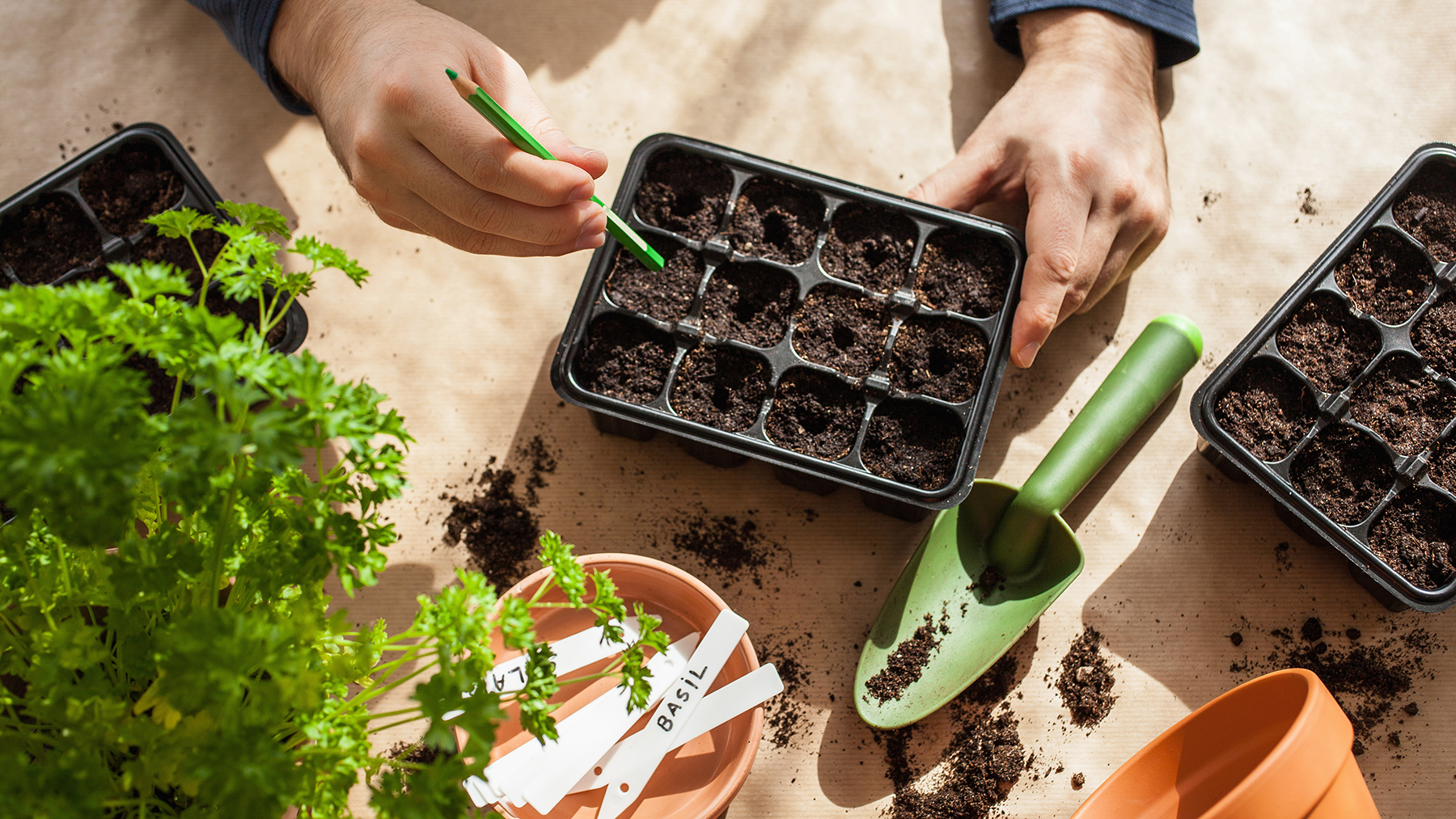Garden expert reveals the 3 seeds you should be planting right now for best results in your yard
Grow your own from seed

As we move into spring, it’s time to gather your gardening tools and head out to the potting shed. Knowing that the bitter frosts are behind us for another year, it’s a prime opportunity to embrace the warmer climes to grow your own.
Nothing is more rewarding than sowing seeds, watching the seedlings grow into plants, harvesting your crop, and cooking up a feast. All it takes is a little know-how to get it right.
There’s nothing to fear — you don’t have to be an experienced gardener to give it a go. We’ve asked garden expert and author Simon Akeroyd to share his top tips on sowing seeds, so whether you’re a novice gardener or enjoy potting about but haven’t grown your own before, you'll soon have the confidence to get sowing.
So grab your gardening gloves and discover the best way to sow carrots, peas, and herbs in your own patch.
1. Carrots

Carrots are known as a cool weather crop and can be planted in early spring once the temperature reaches about 50°F, so bear this in mind when sowing your seeds.
Where to sow
As carrots don’t mind a cool climate, Akeroyd says the time is right to sow them outside now. “I live on the English Riviera in Devon and we hardly get any frosts,” he says, “but if you live in a cooler area, you might want to cover them with a fleece.”
He also suggests sowing carrot seeds every few weeks to give yourself a succession of crops — so you can enjoy many weeks of freshly harvested carrots.
Sign up to get the BEST of Tom's Guide direct to your inbox.
Get instant access to breaking news, the hottest reviews, great deals and helpful tips.
How to sow
“Carrot seeds are tiny but should be sown in a shallow drill,” explains Akeroyd. “I create a shallow drill by simply laying a bamboo cane along the row I intend to grow them in, and just depress it into the soil. I then sow the seeds into the depression.”
Tip
Seeds are very tiny and difficult to distribute, so Akeroyd suggests mixing the seeds with sand to make this easier. He prefers to mix the seeds and sand in a spice jar with holes in the lid that can then be used to sprinkle the mix more evenly along each row.
“You can use wood ash instead of sand as a carrier,” says Akeroyd, “although too much wood ash, [as it] can raise the pH of the soil, making it more alkaline.”

Soil type
“Carrots require very light soil,” says Akeroyd. However, he warns, “Remove any stones in the soil as this can cause ‘forking’ where the root hits a stone and causes the root to split.”
Growing conditions
Carrots are fairly tough and will cope with moderately cold weather between mid and late spring.
Germination time
You won’t have to wait long for your seeds to germinate. Carrots should appear after about two weeks, although Akeroyd says, it will depend on the temperature, inside or out, and the amount of light or sunlight they receive.
Transplantation
The easy part about growing carrots is that they don’t need transplanting. “Carrots should always be sown directly into the soil where you intend to grow them,” says Akeroyd. “Because you are after their roots to harvest, they don’t transplant very well if you dig them up to move them.”
2. Peas

There's nothing like growing sweet crunchy peas and enjoying them fresh from their pods. And luckily, they're not too tricky to grow.
Where to sow
It may sound a bit off the wall, but Akeroyd suggests sowing pea seeds in gutters, as it’s a useful method of getting these crops off to an early start. “It’s particularly useful if you have heavy, clay soil in your yard as those conditions can cause them to rot,” he explains.
“By keeping the gutter indoors, I keep mine on the floor in the lounge, much to my family’s horror — it should prevent mice from eating your seed, which is prone to happen if the seed is sown directly in the soil outside at this time of year.”
However, if you have mice indoors, that’s another issue!
How to sow
Akeroyd says peas are best sown in a zigzag pattern within the gutter, with a 2.5 inch gap between each plant. “I just poke about a ½ inch hole in the compost with my finger and pop a pea into each one,” he adds.

Soil type
“Peas like a fertile, well-dug soil,” says Akeroyd, “but I use a general-purpose peat-free compost when sowing into gutters.”
Growing conditions
Just like carrots, peas are fairly tough and will cope with the moderately cold weather between mid and late spring.
Germination time
If you plant peas when the temperature is 50°F or above, they will take between 6-17 days to germinate.
Transplantation
Peas are ready to be transplanted into the soil when they reach about 4 inches high. “Use a hoe or the edge of a rake to create a 2-inch deep x 2-inch wide groove in the soil and then simply slide the pea seedlings out into it,” he explains, “Then, firm the seedling into the soil and erect netting along the row for the peas to scramble up.”
Tip
We’re not all blessed with outside space to grow our own vegetables, but Akeroyd says peas can also be grown indoors. “You can grow them on a windowsill, then, as a delicious treat, harvest their tendrils and shoots as they emerge.”
3. Herbs

Never run out fresh herbs again and learn how to grow your own. They can be grown indoors on window sills or outside in pots or in soil. Discover 7 top tips for growing herbs indoors.
Where to sow
Akeroyd is a resourceful gardener and has a crafty tip for growing herbs. “At this time of year, I grow herb seeds in repurposed milk cartons, as it provides extra protection from cold weather and frosts,” he explains. “It also provides an early crop of herbs to use in the kitchen.
It's also a handy tip if you don't have a garden, or not much room. “By keeping the herbs in the contains you can take a few harvests by snipping some stems with a pair of scissors, and then it should regrow after each time,” he explains. However, if the growth slows, he suggests sowing some more seeds.
He’s just sown parsley, coriander, basil, and Russian tarragon.
@simonakeroydgardener ♬ Flowers - Miley Cyrus
How to sow
When sowing herb seeds, Akeroyd recommends sprinkling the seeds lightly over the surface of damp compost and covering the seeds with a thin layer of compost, slightly under 0.5 inches.
Tip
If growing herbs indoors, they should be watered every few days to give them a good start.

Soil type
“Most herbs like well drained, light soil,” says Akeroyd, “but again, I use a general-purpose, peat-free compost for sowing them in milk containers.”
Growing conditions
Some herbs are hardier than others, and will need some extra TLS. Akeroyd explains. “Some are okay to plant out now with milk container lids down to protect them from any extreme drop in temperatures, but basil is a bit more tender, and I would suggest keeping that one inside at the moment and moving it outside in its cloche in a month or so.”
Germination time
Herbs usually take a few weeks to germinate, although Akeroyd has found that growing them in makeshift cloche milk cartons makes them germinate much faster due to the additional warmth.
Transplantation
The herbs can be kept in their cloches and housed indoors, or completely removed and planted outside.
More from Tom's Guide

Camilla Sharman has worked in publishing and marketing for over 30 years and has covered a wide range of sectors within the business and consumer industries both as a feature, content, and freelance writer.
As a business journalist, Camilla has researched articles for many different sectors from the jewellery industry to finance and tech, charities, and the arts. Whatever she’s covered, she enjoys delving deep and learning the ins and out of different topics, then conveying her research within engaging content that informs the reader. In her spare time, when she’s not in her kitchen experimenting with a new recipe, you’ll find her keeping fit at the gym. In the pool, stretching at a yoga class, or on a spin bike, exercise is her escape time. She also loves the great outdoors and if she’s not pottering about in her garden, she’ll be jumping on her bike for a gentle cycle ride.
